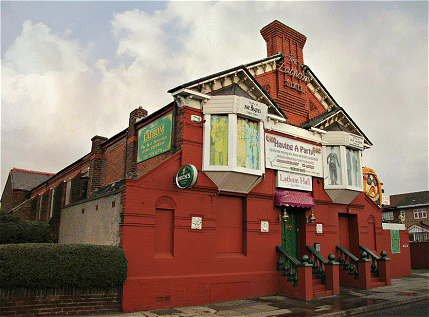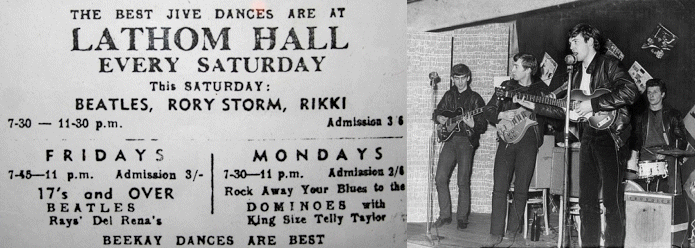Sixties
City presents
a wide-ranging series of
articles on all aspects of the Sixties, penned by the creator of the iconic
60s music paper Mersey
Beat
|
Sixties
City presents
a wide-ranging series of
articles on all aspects of the Sixties, penned by the creator of the iconic
60s music paper Mersey
Beat
|
|||||
|
| A venue
situated in Lathom Avenue, Seaforth, Liverpool L21 which was originally
built in 1884 as a cinema. It became one of several venues, including Litherland
Town Hall and Aintree Institute, promoted by Brian Kelly. It was standard
practice in Liverpool to offer groups ‘auditions’, which would actually
take place at a live show. In other words, the promoter would regularly
have groups playing for free with the enticement that he might book them.
Under the name The Silver Beats, the group who were later to become The Beatles auditioned for Kelly at Lathom Hall during the interval on Saturday 14th May 1960 on a bill which included established Liverpool bands Kingsize Taylor & The Dominoes, Cliff Roberts & The Rockers and The Deltones. As a result of their brief performance, Kelly booked them for the following week, on Saturday 21st May. He advertised the event, which was the first time the group had officially appeared in an advertisement. Despite the fact that they’d only auditioned, the advertisement billed: 'Silver Beats, Dominoes, Deltones'. In spite of the top billing they didn’t turn up for the gig. Instead they left on a tour of Scotland backing Johnny Gentle without informing Kelly who, as a result, didn’t book them again for several months until Bob Wooler talked him into it. Drummer Cliff Roberts recalled The Silver Beats’ appearance that first night on 14th May and said they were a scruffy bunch whose drummer hadn’t even brought his kit and asked if he could borrow Cliff’s. Roberts had a brand new Olympic kit that he hadn’t even used on stage himself, so he naturally refused. However, he agreed to play with The Silver Beats and they performed six numbers together: “four rock ‘n’ roll standards that all of the groups played, and two originals that they had to teach me”. He says that the group then disappeared and he didn’t see them until eight months later when they appeared on the bill at the Alexandra Hall, Crosby on Thursday 19th January 1961, where, says Roberts, “They wore black leather, had brand new instruments and played brilliantly”. All their subsequent appearances at Lathom Hall took place during the first two months of 1961, by which time Kelly was paying them an average of eight pounds and ten pence a performance. Their appearances at the venue took place on 20th, 21st, 28th and 30th January and 4th, 6th, 10th, 11th and 25th February. Their last performance on Saturday 25th February took place on George Harrison’s eighteenth birthday (or so George believed at the time. It was many years later that he discovered he was actually born on 24th February). Incidentally, a group who supported them on a number of Lathom Hall gigs was Faron & The Tempest Tornadoes. It was at Lathom Hall on 14th May 1960 that an incident occurred with troublemakers. In 1966, Neil Aspinall was to recall that the group was often a target for gangs who would shout insults at them because they were either looking for a fight or were annoyed that their girls fancied the foursome. For the sake of peace, the group ignored the taunts. “But it wasn’t easy,” said Neil. “At Lathom Hall…two troublemakers followed Stu Sutcliffe into the dressing-room muttering things like ‘Get your hair cut, girl!’ John and Pete saw this and went after them. A fight broke out and John broke his little finger…It set crooked and never straightened.” |
 |
 |
Stuart
was never seriously injured during the Lathom Hall gig, but this is where
another apocryphal Beatles story had its origins. In the book ‘The Man Who
Gave The Beatles Away’, by Allan Williams and Bill Marshall, journalist
Marshall admitted that he just took the bones of Williams’ memories and
elaborated on them, exaggerating the violence, swearing and sex. In the book he writes, “It was on such a night that Stuart Sutcliffe received the injuries, which I believe hastened his death a couple of years later. Stuart was attacked outside Litherland Town Hall, where The Beatles played regularly, and was kicked in the head by a local thug. From then on he complained to me often of severe headaches.” This is hindsight presuming too much. According to Stuart’s mother, who Stuart revealed everything to; his headaches only began following a fall in Hamburg. Despite the fact that the Williams story was false, it was taken up and elaborated on by writers such as Philip Norman and began to take on a life of its own. In Chet Flippo’s book ‘McCartney: The Biography’, he writes, “In the middle of a jive night at Lathom Hall in Seaforth…that was the night that Stu was attacked and kicked in the head by Teds who didn’t like the Silver Beats’ looks.” Yet Pete Best, though confirming that John suffered a broken finger, clearly states that Stuart was never kicked in the head and was relatively unharmed. Even more bizarre is Albert Goldman’s accusation in ‘The Lives of John Lennon’ that John was responsible for Stuart’s death. “He had gotten into a quarrel with Stu at Hamburg…suddenly John was seized by one of his fits of uncontrollable rage. He lashed out with hands and feet…when he came to his senses he looked down and saw Stu lying on the pavement.” Goldman said that, as a result, John felt completely responsible for Stu’s death. This is complete fiction, but of such stuff, myths are made. After the heyday of the Mersey Sound, the venue became a Royal Navy Club and was then derelict for some time. Brian Corrigan took ownership of the building in 1989, but it was in such a bad shape that, together with his son Dean, he totally revamped the entire premises. |
|
Article
Text
UK
web hosting by
|